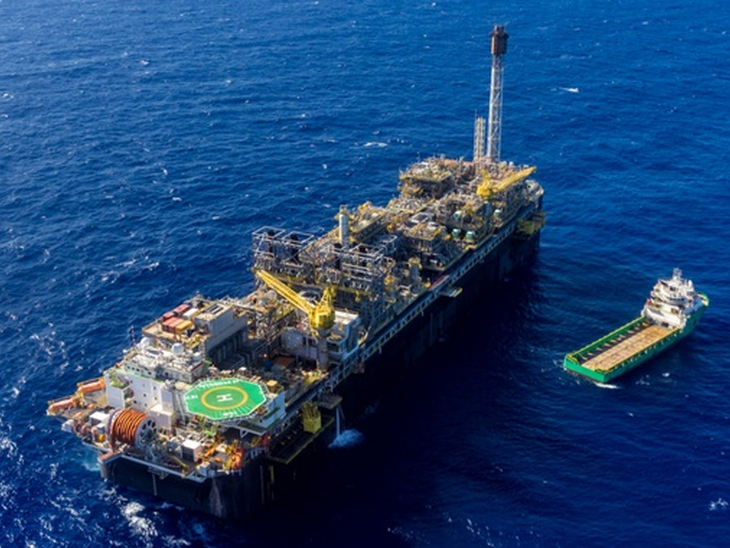
T&B Petroleum/Press Office ANP

Both oil and natural gas production increased in July 2019 from the previous month and the same period last year. Oil production was 2.775 million barrels per day (bbl / d), an increase of 8.5% compared to June and 7.8% compared to July 2018. 124 million cubic meters of gas were produced. per day (m3 / d), an increase of 11.7% over the previous month and 7.1% compared to July 2018.
Oil and gas production totaled around 3.556 million barrels of oil equivalent per day (boe / d), with 61.4% of production (1.732 million boe / d) coming from Pre-salt fields.
July production data are available on the page of the Monthly Oil and Natural Gas Production Bulletin. (http://www.anp.gov.br/publicacoes/boletins-anp/2395-boletim-mensal-da-petroleo-e-gas-natural)
Pre-salt
Pre-salt production from 99 wells was 1.732 million barrels per day (bbl / d) of oil and 71.9 million cubic meters (m³ / d) of natural gas, totaling 2.184 million barrels of oil. oil equivalent per day (boe / d). There was an increase of 12.2% compared to the previous month and 19.9% compared to the same month of 2018. Pre-salt production corresponded to 61.4% of the total produced in Brazil.
Utilization of natural gas
In June, the use of natural gas was 97.2%. 61.8 million m³ / day were made available to the market. Gas flaring in the month was 3.5 million m³ / d. Burning decreased 14.3% compared to the previous month and 10.5% compared to the same month in 2018.
Producer fields
Lula, in the Santos Basin, produced the most oil, an average of 928,000 bbl / d. It was also the largest producer of natural gas: an average of 39.5 million m³ / day.
Origin of production
The maritime fields produced 96.4% of oil and 80.3% of natural gas. The fields operated by Petrobras produced 92.9% of oil and natural gas. Regarding the fields operated by Petrobras, with exclusive participation, they produced 42.5% of the total. National production took place in 7,121 wells, 648 maritime and 6,473 terrestrial.
Highlights
Estreito, in the Potiguar Basin, had the largest number of onshore producing wells: 1,100.
Marlim Sul, in the Campos Basin, was the maritime field with the largest number of producing wells: 67.
The FPSO Cidade de Maricá Platform, producing in Lula Field through seven wells connected to it, produced 147.5 Mbbl / d and was the facility with the highest oil production.
The Polo Arara facility, producing in the Arara Azul, Araracanga, Carapanauba, Cupiuba, Urucu River and Sudoeste Urucu fields, through 37 interconnected wells, produced 8.6 MMm³ / d and was the largest natural gas production facility.
Marginal Accumulation Fields
These fields produced 68.5 barrels of oil per day (bbl / d) and 6,600 cubic meters of natural gas per day (m³ / day). The Iraí field, operated by Petroborn, was the largest producer, with 38.3 barrels of oil equivalent per day (boe / d).
Other information
In June 2019, 293 granted areas, two onerous assignment areas and five sharing areas, operated by 31 companies, were responsible for national production. Of these, 72 are maritime and 228 terrestrial. Of the total producing areas, 10 are related to contracts of areas containing marginal accumulations.
The average API grade was 27.5 and 37.4% of the production considered light oil (> = 31 ° API), 51.7% medium oil (> = 22 API and <31 API) and 10.9% heavy oil. (<22 API).
The mature terrestrial basins (fields / long-term tests of the Espírito Santo, Potiguar, Recôncavo, Sergipe and Alagoas basins) produced 104.3 thousand boe / d, of which 82.1 thousand bbl / d of oil and 3.5 million m³ / d of natural gas. Of this total, 97,400 boe / d were produced by Petrobras and 6,800 boe / d were produced by concessions not operated by Petrobras, of which: 348 boe / d in Alagoas, 3,760 boe / d in Bahia, 24 boe / d in Espírito Santo, 2,485 boe / d in Rio Grande do Norte and 206 boe / d in Sergipe.

Contact us